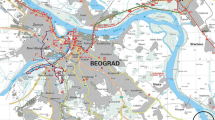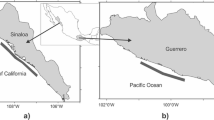Abstract
With the aim of giving an overview on concentration and distribution of Cd, Cu, and Pb in fish from the coasts of Sinaloa state (SE Gulf of California), specimens with different feeding habits were collected in five locations. Sampling occurred between June 2003 and March 2004. Metal analyses on fish tissues were made by graphite furnace (Cd, Pb) and flame (Cu) atomic absorption spectrophotometry. Metal concentrations in tissues of carnivorous fish were grouped together and compared with corresponding concentrations in non-carnivorous fish; Cu and Pb levels were significantly (p < 0.05) higher in liver of non-carnivorous species. Though no samples exceeded the maximum level set in international legislation for fish, from the perspective of the public health and considering the legal limits of fishery products for human consumption, Cu concentrations were exceeded (in tissues different from muscle) in four carnivorous and five non-carnivorous species according to the Australian legislation. In the case of Cd, two carnivorous species (Pomadasys leuciscus and Caulolatilus princeps) and one non-carnivorous species (Mugil cephalus), showed concentrations over the maximum level of 2 μg g − 1 dry weight considered in the Mexican legislation. Considering average amounts of fish consumption in Mexico, daily mineral intake (DMI) values for Cu and percentage weekly intake (PWI) of Cd and Pb were estimated; none of the analyzed metals in edible portion of analyzed fish could be detrimental to humans.
Similar content being viewed by others
References
Allen, G. R., Bauchot, M. L., Bellwood, D. R., Bianchi, G., et al. (1995a). Peces óseos. In W. Fischer, F. Krupp, W. Schneider, C. Sommer, K. E. Carpenter, & V. H. Niem (Eds.), Guía FAO para la identificación de especies para los fines de la pesca. Pacífico Centro-oriental. Volumen II. Vertebrados-Parte 1 (pp. 647–1200). Roma: FAO.
Allen, G. R., Bauchot, M. L., Bellwood, D. R., Bianchi, G., et al. (1995b). Peces óseos. In W. Fischer, F. Krupp, W. Schneider, C. Sommer, K. E. Carpenter, V. H. Niem (Eds.), Guía FAO para la identificación de especies para los fines de la pesca. Pacífico Centro-oriental. Volumen II. Vertebrados-Parte 1 (pp. 1201–1813). Roma: FAO.
Alongi, D. M. (1998). Coastal ecosystem processes. Boca Raton, Florida: CRC Press.
Amiard, J. C., Amiard-Triquet, C., Metayer, C., Marchand, J., & Ferre, R. (1980). Study on the transfer of Cd, Pb, Cu and Zn in neritic and estuarine trophic chains. I. The inner estuary of the Loire (France) in the summer of 1978. Water Research, 14, 665–673. doi:10.1016/0043-1354(80)90125-6.
Andres, S., Ribeyre, J. N., & Boudou, A. (2000). Interspecific comparison of cadmium and zinc contamination in the organs of four fish species along a polymetallic pollution gradient (Lot River, France). The Science of the Total Environment, 48, 11–25. doi:10.1016/S0048–9697(99)00477–5.
Barwick, M., & Maher, W. (2003). Biotransference and biomagnification of selenium, copper, cadmium, zinc, arsenic and lead in a temperate seagrass ecosystem from Lake Macquarie estuary, NSW, Australia. Marine Environmental Research, 56, 471–502. doi:10.1016/S0141-1136(03)00028-X.
Brooks, R. R., & Rumsey, D. (1974). Heavy metals in some New Zealand commercial sea fishes. New Zealand Journal of Marine and Freshwater Research, 8(1), 155–166.
Canli, M., & Atli, G. (2003). The relationships between heavy metal (Cd, Cr, Cu, Fe, Pb, Zn) levels and the size of six Mediterranean fish species. Environmental Pollution, 121(1), 129–136. doi:10.1016/S0269-7491(02)00194-X.
Carvalho, F. P., Fowler, S. W., González-Farías, F., Mee, L. D., & Readman, J. W. (1996). Agrochemical residues in the Altata-Ensenada del Pabellón coastal lagoon (Sinaloa, Mexico): A need for integrated coastal zone management. International Journal of Environmental Health Research, 6, 209–220. doi:10.1080/09603129609356892.
Chan, K. M. (1995). Concentrations of copper, zinc, cadmium and lead in rabbitfish (Siganus oramin) collected in Victoria Harbour, Hong Kong. Marine Pollution Bulletin, 31(4–12), 277–280.
Cifuentes-Lemus, J. L. (2002). Introducción. In J. L. Cifuentes-Lemus, & J. Gaxiola-López (Eds.), Atlas de la Biodiversidad de Sinaloa (pp. 21–24). Culiacán: El Colegio de Sinaloa.
Cruz-Agüero, J. A. (2002). Peces marinos de Sinaloa: Historia, distribución y diversidad. In J. L. Cifuentes-Lemus, & J. Gaxiola-López (Eds.), Atlas de la Biodiversidad de Sinaloa (pp. 301–310). Culiacán: El Colegio de Sinaloa.
Dean, J. G., Bosqui, F. L., & Lanouette, K. H. (1972). Removing heavy metals from waste water. Environmental Science & Technology, 6(6), 518–522. doi:10.1021/es60065a006.
Dietz, R., Riget, F., Cleeman, M., Aarkrog, A., Johansen, P., & Hansen, J. C. (2000). Comparison of contaminants from different trophic levels and ecosystems. The Science of the Total Environment, 245, 221–231. doi:10.1016/S0048-9697(99)00447-7.
Egeland, G. M., & Middaugh, J. P. (1997). Balancing fish consumption benefits with mercury exposure. Science, 278, 1904–1905.
Furness, R. W., & Rainbow, P. S. (Eds.). (1990). Heavy metals in the marine environment. Florida: CRC.
Galarini, R., Haouet, M. N., & Elia, A. C. (2002). Heavy metals, HCB and p,p’-DDE in Ictalurus melas Raf. from Trasimeno and Corbara lakes, Italy. Bulletin of Environmental Contamination and Toxicology, 68, 230–236. doi:10.1007/s00128-001-0243-3.
Giordano, R., Arata, P., Ciaralli, L., Rinaldi, S., Giani, M., Cicero, A. M., & Costantini, S. (1991). Heavy metals in mussels and fish from Italian coastal waters. Marine Pollution Bulletin, 22(1), 10–14. doi:10.1016/0025-326X(91)90438-X.
Gutleb, A. C., Helsberg, A., & Mitchell, C. (2002). Heavy metal concentrations in fish from a pristine rainforest valley in Peru: a baseline study before the start of oil-drilling activities. Bulletin of Environmental Contamination and Toxicology, 69, 523–529. doi:10.1007/s00128-002-0093-7.
IAEA. (1990). The fate of agrochemicals in tropical coastal lagoon ecosystems. Progress report Year 1. Contract No. CI 1–0387-ME (JR). International Atomic Energy Agency: Monaco.
Izaguirre-Fierro, G., Páez-Osuna, F., & Osuna-López, J. I. (1992). Heavy metals in fishes from Culiacán valley, Sinaloa, Mexico. Ciencias Marinas, 18(3), 143–151.
Luoma, S. N., & Rainbow, P. S. (2005). Why is metal bioaccumulation so variable? Biodynamics as a unifying concept. Environmental Science & Technology, 39(7), 1921–1931. doi:10.1021/es048947e.
MESL, Marine Environmental Studies Laboratory. (1997). International Atomic Energy Agency. Inorganic Laboratory, Standard Operating Procedures. Monaco, pp. 66.
Moody, J. R., & Lindstrom, R. N. (1977). Selection and cleaning of plastic containers for storage of trace element samples. Analytical Chemistry, 49, 2264–2267. doi:10.1021/ac50022a039.
Mormede, S., & Davies, I. M. (2001). Trace elements in deep water fish species from the Rockall Trough. Fisheries Research, 51(2–3), 197–206. doi:10.1016/S0165-7836(01)00245-4.
Nauen, C. E. (1983). Compilation of legal limits for hazardous substances in fish and fishery products. FAO Fisheries Circular, 764, 102.
Norma Oficial Mexicana (1993). NOM-027-SSA1-1993. Pescados frescos-refrigerados y congelados.
Páez-Osuna, F., Bojórquez-Leyva, H., & Ruelas-Inzunza, J. (1999). Regional variations of heavy metal concentrations in tissues of barnacles from the subtropical Pacific coast of Mexico. Environment International, 25(5), 647–654. doi:10.1016/S0160-4120(99)00032-X.
Pentreath, R. J. (1977). The accumulation from water of 65Zn, 54Mn, 58Co and 59Fe by the mussel, Mytilus edulis. Journal of the Marine Biological Association of the United Kingdom, 53, 127–143.
Phillips, D. J. H. (1977). The use of biological indicator organisms to monitor trace metal pollution in marine and estuarine environments—A review. Environmental Pollution, 13, 281–317. doi:10.1016/0013-9327(77)90047-7.
Rainbow, P. S. (1993). Biomonitoring of marine heavy metal pollution and its application in Hong Kong waters. The Marine Biology of the South China Sea. Proceedings of the First International Conference on the Marine Biology of Hong Kong and the South China sea (pp. 235–250).
Ruelas-Inzunza, J., & Páez-Osuna, F. (2005). Mercury in fish and shark tissues from two coastal lagoons in the Gulf of California, Mexico. Bulletin of Environmental Contamination and Toxicology, 74, 294–300. doi:10.1007/s00128-004-0583-x.
Ruelas-Inzunza, J., & Páez-Osuna, F. (2007a). Essential and toxic metals in nine fish species for human consumption from two coastal lagoons in the Eastern Gulf of California. Journal of Environmental Science and Health Part A, 42, 1411–1416. doi:10.1080/10934520701480615.
Ruelas-Inzunza, J., & Páez-Osuna, F. (2007b). Trophic distribution of Cd, Pb, and Zn in a food web from Altata-Ensenada del Pabellón subtropical lagoon, SE Gulf of California. Archives of Environmental Contamination and Toxicology. doi:10.1007/s00244-007-9075-4.
Ruelas-Inzunza, J., Meza-López, G., & Páez-Osuna, F. (2008). Mercury in fish that are of dietary importance from the coasts of Sinaloa (SE Gulf of California). Journal of Food Composition and Analysis, 21, 211–218. doi:10.1016/j.jfca.2007.11.004.
Simkiss, K., & Mason, A. Z. (1983). Metal ions: metabolic and toxic effects. In K. M. Wilbur (Ed.), The Mollusca, environmental biochemistry and physiology, (vol. 2, pp. 101–164). USA: Academic.
Soto-Jiménez, M., Páez-Osuna, F., Scelfo, G., Hibdon, S., Franks, R., Aggarawl, J., & Flegal, A. R. (2008). Lead pollution in subtropical ecosystems on the SE Gulf of California Coast: A study of concentrations and isotopic composition. Marine Environmental Research, 66, 451–458. doi:10.1016/j.marenvres.2008.07.009.
Storelli, M. M., Giacominelli, R., Storelli, A., & Marcotrigiano, G. O. (2005). Accumulation of mercury, cadmium, lead and arsenic in swordfish and bluefin tuna from the Mediterranean sea: A comparative study. Marine Pollution Bulletin, 44, 281–288.
Szefer, P. (1991). Interphase and trophic relationships of metals in a southern Baltic ecosystem. The Science of the Total Environment, 101, 201–215. doi:10.1016/0048-9697(91)90034-C.
UNEP. (1993). Guidelines for monitoring chemical contaminants in the sea using marine organisms. Reference methods for marine pollution studies. No. 6.
Wang, W.-X., Fisher, N. S., & Luoma, S. N. (1996). Kinetic determinations of trace element bioaccumulation in the mussel Mytilus edulis. Marine Ecology Progress Series, 140, 91–113. doi:10.3354/meps140091.
Watling, H. R. (1983). Accumulation of seven metals by Crassostrea gigas, C. margaritacea, Perna perna and Chromytillus meridionalis. Bulletin of Environmental Contamination and Toxicology, 30, 213–320. doi:10.1007/BF01610139.
WHO (2003, August). Nutrition. Retrieved from www.who.int/nut/research1.htm.
Zhou, H. Y., Cheung, R. Y. H., Chan, K. M., & Wong, M. H. (1998). Metal concentrations in sediments and Tilapia collected from inland waters of Hong Kong. Water Research, 32(11), 3331–3340. doi:10.1016/S0043-1354(98)00115-8.
Author information
Authors and Affiliations
Corresponding author
Rights and permissions
About this article
Cite this article
Ruelas-Inzunza, J., Páez-Osuna, F. & García-Flores, D. Essential (Cu) and nonessential (Cd and Pb) metals in ichthyofauna from the coasts of Sinaloa state (SE Gulf of California). Environ Monit Assess 162, 251–263 (2010). https://doi.org/10.1007/s10661-009-0793-0
Received:
Accepted:
Published:
Issue Date:
DOI: https://doi.org/10.1007/s10661-009-0793-0




